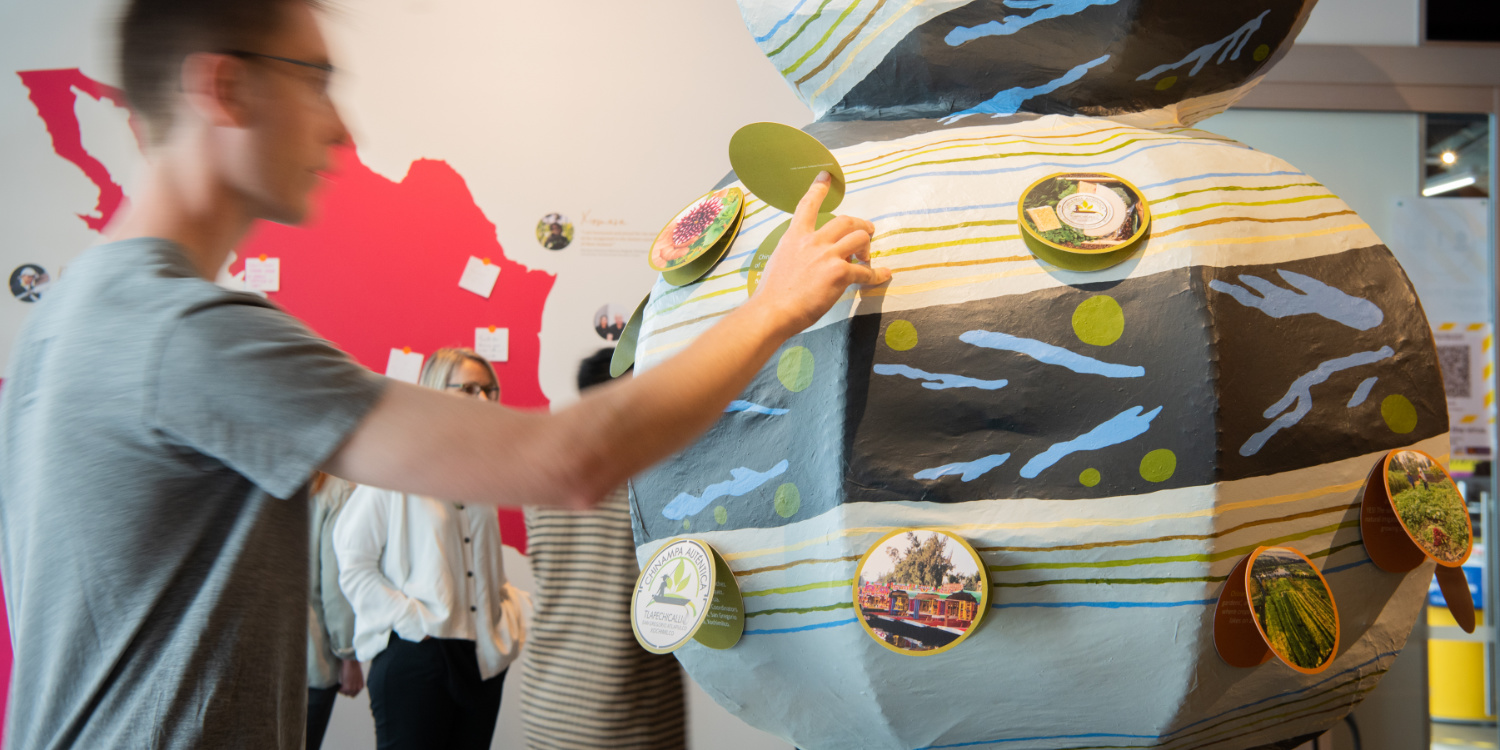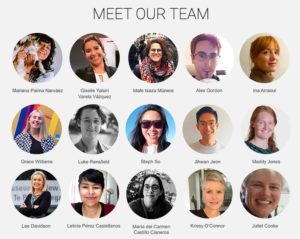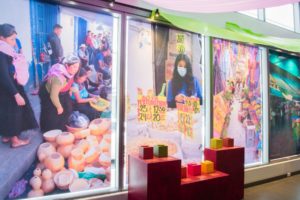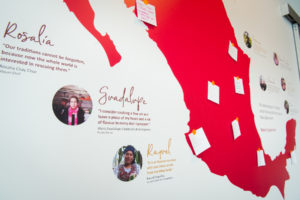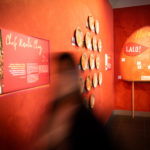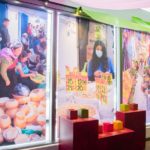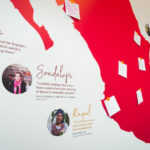On March 16, 2021, at Te Auaha Gallery, in the heart of Wellington’s cultural and creative precinct, over 100 guests gathered for the launch of De la Milpa a la Mesa: A Mexican Food Journey – an exhibition about Mexico for New Zealanders, developed by an intercultural team. This is the second of two articles that explain how we reimagined international exhibition exchange as remote intercultural exhibition development through the De la Milpa a la Mesa project. In Part I, we looked at the exhibition drivers, the remote collaboration model we adopted and how we worked together using the principles of intercultural practice developed in our book Cosmopolitan Ambassadors1.
We finished Part I with the bold claim that while our project was challenging we had achieved ‘proof of concept’ – that an intercultural exhibition can be conceptualised and delivered entirely remotely with sensitive, effective, and flexible processes. In Part II we look more closely at the strategies we used to develop an exhibition that promotes intercultural understanding and then turn to how we evaluated its success.
Strategies for developing an exhibition that promotes intercultural understanding
It is often claimed that international exhibitions promote understanding among cultures, but there is also the risk that they reproduce stereotypes and shallow representations of culture. Through our research, we came to understand that these risks can be overcome by applying what we term intercultural museum practices to conceptualise and produce international exhibitions.
Our exhibition team included Mexicans (working from Mexico) and New Zealanders, some of whom were bi-lingual (and one of these being a New Zealand-Colombian). The practices we adopted were based on open dialogue and constant communication taking into consideration the need to be respectful, open, patient, adaptable, genuine, curious, and empathetic to different cultural perspectives, as well as taking the time to have debates and conversations about cultural representation and reach shared understandings.
Our research told us that visitors have certain preferences for how they like to connect with other cultures. They:
- want to engage with the everyday “reality” of a culture
- want to explore issues of relevance to their daily lives, to better understand themselves and the world around them
- like exhibitions with a clear purpose or message
We also learned that the best way to encourage audiences to engage with different cultural perspectives, “to see things through others’ eyes” and re-evaluate superficial stereotypes, was to design for different levels of comfort with cultural difference and to create spaces where people can engage in playful and reflective ways. First then, we needed to understand our audience’s level of prior knowledge and preconceptions about Mexican culture so that we could create points of connection with what they already knew, while at the same time avoiding clichés and stereotypes. Existing research told us that New Zealanders’ positive perceptions of Latin America included ‘Happy/ Fun/ Friendly’, ‘Vibrant/ Energy’ and ‘food/cuisine’, while negative perceptions included ‘Drugs’, ‘Crime’ and ‘Poverty/ Inequality’.
After discussing several proposals, we decided to focus our exhibition on Mexican cuisine and the agricultural heritage from which it has evolved. While Mexican cuisine was something our audiences could immediately relate to, we wanted to expand their understanding of exactly how rich and diverse this cuisine is, and how central a role it plays in Mexican culture. By also talking about Mexico’s World Heritage recognised agricultural systems, we wanted to challenge negative stereotypes by showing the long history of incredible innovation and ingenuity and its contribution to food and agriculture around the globe. Agriculture, innovation and ingenuity are very central to New Zealand history and contemporary society, so we felt this would be a good point of connection and help to generate curiosity and respect. We also chose themes within the broader concept that included current challenges for both New Zealanders and Mexicans, such as biodiversity loss, food sovereignty, natural disasters, climate change and the pandemic.
Along with trying to shift negative stereotypes, we wanted the exhibition to be a polyvocal space giving Mexican voices a platform to tell their own stories. To encourage empathy and ‘perspective taking’ for each of our three key themes – milpa (farm), mercado (market) and mesa (table) – we selected one or more stories from ‘everyday’ Mexicans (farmers, cooks, scientists, etc) and focused more on their personal stories as the ‘faces’ of Mexico rather than providing extensive information. From interviews with our ‘faces’ we selected key quotes (in original Spanish with English translation) to accompany a photo they supplied and a short text of no more than 150 words.
To make the exhibition engaging and playful – and because we were not able to include actual objects from Mexico – we worked with a Wellington-based Mexican papier-maché artist to design and build five large-scale, colourful papier-maché sculptures, inspired by themes of Mexican agriculture, that helped to deliver the interpretation. Our immersive mercado space included smell boxes with Mexican herbs and spices, life-sized photo murals of Mexican market scenes and a soundtrack recorded by one of our team members in their local tianguis (open-air market). We had a range of simple interactives the visitors could move to read, and two paper and pencil interactives where visitors could design their own ‘fusion dish’ of Mexican-New Zealand cuisine and leave a message for one of the exhibition’s ‘faces’ – providing a space for reflection and participation so visitors’ voices could be inserted in the exhibition as well.
Polyvocality and play were also facilitated by our programme of events which provided opportunities for the public to take a deep dive into aspects of Mexican language and culture, building on the themes of the exhibition. These events were selected and delivered with the local Mexican community and included a Mexican food masterclass and tasting night, a series of five free language classes, a Mexican dance and music workshop, a night of Mexican literature, a talk about the history of cacao with free hot chocolate, a free documentary film night and a print workshop using a tortilla press.
Indicators of success
How successful has De la Milpa a la Mesa been? Did it enhance intercultural understanding for its project team and visitors? Visitor numbers and revenue generated (or lost) have often been used as defacto measures of the success (or failure) of international exhibitions. In Cosmopolitan Ambassadors we explored perceptions of the value of international exhibitions —not only as a tool for diplomatic agendas, but also in terms of their interconnected market-oriented and mission-related domains. This raised the tricky question of how this value might be measured as these projects have been critiqued for the lack of any evidence of, or even reliable methods for assessing, their value. The language of success has broad implications for how the current and future roles of international exhibitions are framed.
Carol Scott, a leading expert on museum value, argues that the museum sector is “hindered by its failure to clearly articulate its value in a cohesive and meaningful way, as well as by its neglect of the compelling need to establish a system for collecting evidence around a set of agreed indicators that substantiate value claims”.2 We need to broaden the ways we articulate and demonstrate value using both traditional quantitative measures alongside qualitative indicators that represent a new language for narrating the social purpose of museums, including international exhibitions.
First, it is important to distinguish between three words that are often used interchangeably: outcomes, impact, and values. Perceptions of value as “actual or potential benefit”3 inform museum outputs like international exhibitions, with the intention that they will result in certain impacts that can be assessed through the evaluation of outcomes. Short-term outcomes are often represented by measures such as visitation, satisfaction, attendance at events, and so on. While these are convenient measures of success, they fail to capture the full value of international exhibitions. Longer-term and less tangible outcomes are much more challenging to evaluate, and causation is difficult to prove. A solution is to rely on indicators to show a contribution to impact, rather than claiming causation and the possibility of precise measurement.4
In Part I we argued that it is important to clearly articulate a range of drivers at the outset of an exhibition project so that impacts can then be evaluated using an appropriate set of indicators at the project’s conclusion. We outlined the drivers for De la Milpa a la Mesa as primarily mission-related and divided between ourselves – as the project leads – and the exhibition funders, the Latin American Centre of Asia-Pacific Excellence (LatAmCAPE). For each driver we articulated the impact we hoped to achieve and potential indicators for that impact. These were a combination of quantitative and qualitative indicators to capture both the tangible and intangible value of the exhibition. Throughout the project we intentionally gathered data that would relate to each indicator. The core exhibition team kept reflective journals during the development process, completed an evaluation at its conclusion, and were interviewed several months after the project. We completed visitor counts, observations, and a survey.
As project leads, a key driver for us was the opportunity to test and refine theories from our book, and impact museum practice. We articulated basic quantitative indicators including: the number of practitioners involved in the project; the duration of the collaboration; and the number of seminars and articles produced. But we also wanted indicators for the more intangible outcomes, such as the quality of the experience for the team, enhanced intercultural knowledge, skills and perspectives, and impact on future practice. These types of indicators would not be nice tidy numbers, but quotes and stories collected through the interviews and journals to capture “museum practice”.5
For example, from the interviews and journals we were able to show that participants from both countries had positive experiences, and increased knowledge of respective cultural sectors and perspectives:
“It was so nice to open my mind up again to the world and think about Mexico and what people are doing there and all the museums and collections that are all around the world.”
“Because I’ve been part of the, I guess, cross cultural part of the exhibition project, being involved with Latin America, I do notice a whole lot more Latin American things now.”
Participants told us that the project gave them confidence to pursue their own creative and intercultural projects and talked about their desire to expand their horizons. The Mexican team members particularly appreciated the indigenous museum practices that have been incorporated into standard museum protocols in New Zealand such the Māori blessing before the exhibition opened. This led them to reflect on the differences in indigenous people’s involvement in exhibitions in Mexico.
We also found evidence of participants adopting intercultural practices and having changed perspectives or ‘cosmopolitan’ insights. For the Mexican team these included an appreciation of their own culture re-evaluated through the “eyes of the other”; that is, the New Zealand team and the prospective audience.
“So that’s interesting, how an exhibition organized between two cultures to show content to another culture, makes you reflect on your same culture.”
For the New Zealand team members, we found ‘cosmopolitan moments’ oriented to a reevaluation and expansion of their knowledge about Mexican culture and its diversity.
“It really— It transformed my understanding of Latin America, and specifically Mexico, because I guess it wasn’t a part of the world I had engaged with previously, and everything I knew about it was from like Tex-Mex restaurants or like movies that are really racist and awful.”
The desired outcomes for the LatAmCAPE were to train emerging professionals in New Zealand’s cultural and creative sectors to work collaboratively in Latin America and to deliver projects aimed at deepening New Zealanders’ knowledge and appreciation of the region. There was some overlap here with our own indicators, with the addition of quantitative and qualitative indicators relating to the number of onsite and online visits to the exhibition and evidence of enhanced awareness of importance of the Latin American region to New Zealand. Here is a snapshot of the measures/indicators of success we produced by counting, observing, and surveying visitors:
- The exhibition reached a sizable audience (approximately 4500) in a relatively short timeframe of 6-weeks, including 171 students on guided school visits and 195 participants in our events programme. Around three-quarters spent more than 20 minutes in the exhibition.6
- Visitor praised the quality of the exhibition and the uniqueness of showcasing LatAm culture in NZ. The exhibition felt ‘real’ to people and gave them an informed understanding, beyond the stereotypes. They reported that they were engaged sensorily, imaginatively, emotionally, and mentally. It led them to reflect on another way of life and gave them a sense of respect for others.
- Over half (55%) of visitors rated either reading the personal stories or watching the videos (which were about one of our ‘faces’) as their favourite activity in the exhibition. Asked what they liked about this activity, most said it help connect them with ‘real people’.
- Visitors were inspired to find out more about Mexico (94%) and Latin American (92%) cultures; 91% said their visit had changed their understanding of Mexico.
- When asked what had changed visitors said their understanding of Mexico had been expanded. For example:
“I didn’t know Mexico was employing sustainable farming practices and I didn’t know that all the different areas of Mexico had their own local dish.“
“It’s a different way to see a Latin American country. Very interesting!“
“[I] have gone from stereotypical style tropes to a more informed understanding.“
“[I have] more knowledge of what life is like for farmers and people living in the country.” - They also expressed their own ‘cosmopolitan moments’:
“How dependant we all are on agriculture.”
“More opened minded.”
“Remembering Mexico is populated by real people and not just ‘some country across the sea’.”
Conclusions
De la Milpa a la Mesa is now on tour and being shown in venues around New Zealand as diverse as a public library, a community cultural centre and a contemporary art gallery. It is proof that international exhibitions are possible without a large-scale budget, and the need to move collections or people across international borders. We have also demonstrated that exhibitions that purposefully incorporate intercultural practices can have high quality intercultural outcomes and impacts, helping to avoid negative stereotypes and open the door for more mutual understanding between cultures. We feel we were able to do this because we had clear objectives and intentions from the beginning of the project, decided what the indicators would be and had a plan to collect the necessary information. We hope that more international exhibitions will follow these processes so we can build an ever-expanding body of evidence about their effectiveness and continue to refine our practices. Please get in touch with us if you want to know more about our display strategies and/or indicators of success and join us in this project.
Sources
1 Davidson, L., & Pérez Castellanos, L. (2019). Cosmopolitan Ambassadors: International exhibitions, cultural diplomacy and the polycentral museum. Wilmington, Delaware: Vernon Press.
2 Scott, Carol. 2009. “Exploring the Evidence Base for Museum Value.” Museum Management and Curatorship 24 (3): 195–212.
3 Scott, Carol, Jocelyn Dodd, and Richard Sandell. 2014. “Cultural Value: User Value of Museums and Galleries: A Critical View of the Literature.” Arts & Humanities Council.
4 Bollo, Alessandro. 2013. Measuring Museum Impacts. The Learning Museum Network Project.
5 There is a lack of understanding and theorizing around day-to-day museums practices, from which we can learn a lot (see McCarthy, Conal. 2015. “Grounding Museum Studies: Introducing Practice.” In Museum Practice, edited by Conal McCarthy. The International Handbooks of Museum Studies. Chichester, West Sussex: John Wiley & Sons, Ltd.). The reflective journals as well as the interviews were ways to capture this intangible side of what people actually do in museums.
6 Visitors spend an average of 20 minutes in an exhibition (see Serrell, Beverly. 2020. “The Aggregation of Tracking-and-Timing Visitor-Use Data of Museum Exhibitions for Benchmarks of ‘Thorough Use’.” Visitor Studies, 23 (1): 1-17.)
Website
For more information about our research, publications and consultancy services: polycentralmuseum.com
Book
Cosmopolitan Ambassadors: International exhibitions, cultural diplomacy and the polycentral museum (Vernon Press, 2019). Available at https://vernonpress.com/book/747
Spanish Edition: Embajadoras cosmopolitas. Exposiciones internacionales, diplomacia cultural y el museo policentral. (Vernon Press, 2020). Available at https://vernonpress.com/book/970
About the authors & contributors
Dr Lee Davidson has 20 years’ experience as a teacher and researcher at Victoria University of Wellington, where she is part of New Zealand’s leading programme in museum and heritage studies. Her work is firmly grounded in theory and practice and she has built close collaborative relationships with key national and international cultural institutions, particularly the Museum of New Zealand, Te Papa Tongarewa. She is an experienced facilitator of workshops and symposia for museum and heritage professionals and also works as a research consultant for external organisations. She regularly presents at international conferences and has published widely on visitor studies, intercultural practice, museum diplomacy, international exhibitions and heritage tourism.
Leticia Pérez-Castellanos is a professor at the Escuela Nacional de Conservación, Restauración y Museografía del Instituto Nacional de Antropología e Historia (INAH) in México, where she coordinated the Post Graduate Studies Program in Museology and obtained her Master's Degree. Her focus is on visitor studies and international exhibitions. She was the Coordinator of Visitor Studies at the Interactive Museum of Economy (MIDE), before becoming Deputy Director of International Exhibitions at INAH. She collaborated with the Ibermuseos Program in the implementation of the Observatorio Iberoamericano de Museos. She is a key actor in strengthening the visitor studies field in Latin America, encouraging professionalization and publications in Spanish.


